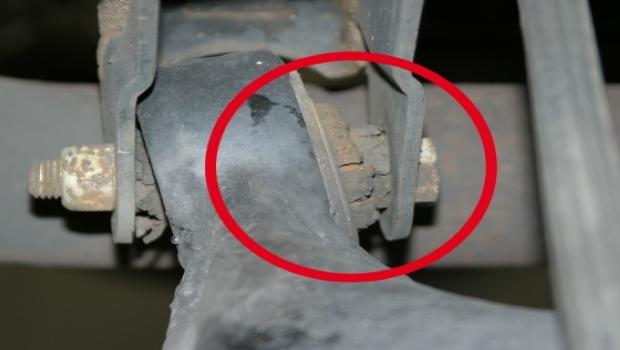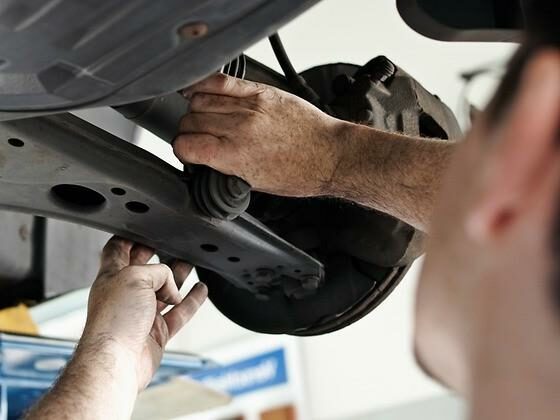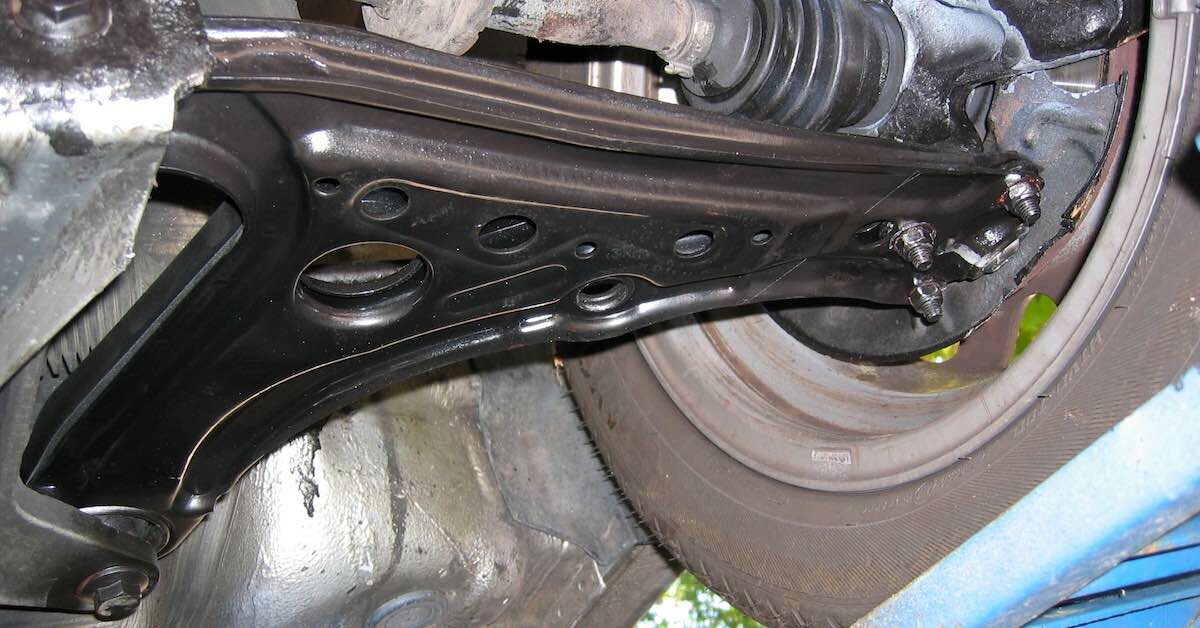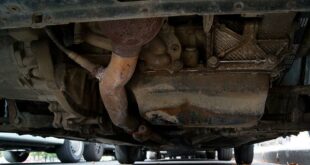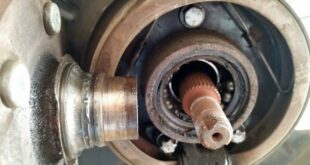Recently updated on October 17, 2023 at 11:52 am
[Update: 17.10.2023] This post was updatedto take more recent information into account. Depending on the manufacturer and vehicle class, the design of the front wheel suspension varies greatly. The wishbones are for one moving connection between the wheel carrier and the chassis. While driving, they absorb the forces that arise when braking, accelerating and compressing the wheel. There can be various types of damage to the wishbones due to wear and aging. On the one hand, the wishbone bearings wear out at the ends (also called wishbone bushings or rubber mounts), on the other hand, the ball joints can be knocked out. In rare cases, corrosion on the control arm is a problem. Serious damage usually only occurs in the event of severe violence, for example an accident.
Change the wishbone yourself
Rattling and rumbling, imprecise directional stability, spongy driving or cracking when turning. The best way to identify a worn wishbone is by the noise when turning (often metallic noise) recognize. To check whether the control arm is worn out, you can jack up the car (unless a lift is available) and grab the wheel left and right and up and down. If the wheel should not be stuck, this confirms the suspicion on a worn wishbone bearing. However, play on the wheel or rattling noises can also be caused by various components of the steering and chassis. After an initial suspicion, a workshop must find out the exact source of the fault in order to avoid an unnecessary replacement of intact parts.
What to confuse the worn control arm with?
The fact that a wheel has play can also have other causes. A worn-out axial joint in the tie rod, worn dome bearings, a worn-out steering gear, a worn-out tie rod end, a defective wheel bearing or an incorrectly fastened wheel can be a sign. Is it possible to continue driving with a worn wishbone bearing?? If the wishbone bearing is worn, the tires will wear out more, there will be annoying noise when driving and the wheel guidance will be poor. The wear and tear also results in unsafe driving behavior and a higher safety risk. When accelerating and braking, this can also pull to the side from the car, have a negative impact on driving safety and driving comfort.
Main inspection and worn wishbone
If a wishbone is knocked out or a rubber mount is damaged, this is a considerable lack and that ensures that you get the main inspection does not exist. The same applies to a bent or damaged control arm. If it's just a rubber mount detachment, it's possible that it's just a slight deficiency is evaluated and the car passes the main inspection.
Changing or repairing the control arm
First of all, you have to ask yourself whether repairs or repairs are possible, or whether you have to completely replace the control arm. It is often possible to change the wishbone bushes or wishbone bearings individually by pressing them in or out. However, the costs are often higher for a complete replacement as high as during a repair. It's best to ask the workshop which solution is better. Since wishbones are wearing parts, you should not use used spare parts. It is also recommended to always replace the wishbones axle by axle. There can be several handlebars installed on each side of the wheel, so it is recommended to check them. It is not uncommon for additional handlebars to become defective due to wear.
control arm change
In order to be able to carry out a wishbone change, you have to raise the car with the lifting platform. After that have to bike and maybe they too wheelhouse protection paneling and parts of underbody be removed. Now you have to use the usual triangular wishbone (is most commonly installed) the Wishbone and ball joint dismantle. In order to be able to separate the ball joint from the wishbone, you usually need a special tool. Therefore, a completely new component is often installed. Then the guide bearings and support bearings on the wishbone are completely new. A construction with several wishbones can increase the overall effort. It can also happen that the cone of the ball joint or the fastening screws are stiff due to corrosion and this increases the time required. The wheel position may also be changed as a result of the work. Therefore one should Alignment and wheel alignment be performed.
How high are the costs?
Depending on the vehicle type, a wishbone replacement costs between 50 and 800 euros. The best-known manufacturers are Meyle, MAPCO, TRW and Febi Bilstein. The workload is one to four hours. At an hourly rate of 100 euros, the labor costs are between 100 and 400 euros. Wheel alignment and wheel alignment cost between 50 and 250 euros, depending on the effort involved. If this is not carried out, consequential costs may arise due to increased wear on the tires or chassis. Overall, you can definitely count on total costs of between 200 and 1.250 euros per wheel. The price range is so large because the repair costs and axle constructions vary greatly depending on the manufacturer and vehicle type.
In summary – change the wishbone yourself:
1. What exactly is a wishbone?
The Wishbone, often also referred to as axle control arm, is a central component in the chassis system of motor vehicles. It creates the connection between the frame and the bike. Special bearings allow it to move both vertically and horizontally, allowing for comfortable and safe driving.
2. When should you consider changing the wishbone bearings?
A regular check of the wishbones is recommended. The bearings are particularly susceptible to wear and tear. If you notice a change in driving behavior or unusual noises, this could indicate worn bearings. It is important to change bearings in a timely manner to avoid major damage or safety risks.
3. What symptoms indicate a defective wishbone?
A defective wishbone can show many symptoms:
- Spongy steering feel
- Difficulty staying in lane
- Squeaking or creaking noises
- Rumbling noises, especially on uneven roads
- The vehicle swerves sideways
- One-sided tire wear
4. How do you change a wishbone yourself?
Changing a control arm requires specialist knowledge and the right tools. Here is a detailed step-by-step guide:
- Preparation: Gather all the tools you need. These include, among other things, a car jack, a socket wrench set and a torque wrench.
- Raise the vehicle and remove the wheel: Raise the vehicle with the jack and remove the wheel.
- Identify wishbones: Familiarize yourself with the position and attachment of the control arm.
- Loosen screws: Start with the screws on the vehicle frame. If necessary, use a box wrench.
- Remove wishbone: Carefully pry off the control arm, being careful not to damage any other parts.
- Install new wishbone: Insert the new wishbone and attach it to the designated locations.
- Mount the wheel and lower the vehicle: After everything is secure, you can reinstall the wheel and lower the vehicle.
5. What costs should you expect?
The costs can vary depending on the type of vehicle and whether you do the change yourself or have it done in a workshop. If you do it yourself, the material costs are usually between 20 and 150 EUR. In a workshop, costs between 200 and 600 EUR, including working time, can arise.
The following note is essential: For safety reasons, tuningblog recommends all repair, inspection and maintenance work exclusively to be carried out in a specialist workshop! Although our information is summarized to the best of our knowledge and belief, we cannot assume any liability for the content. All information is therefore "without guarantee".
Of course, that wasn't the end of it!
In this tuning blog category there are guides and instructions on common defects/repairs on the vehicle as well as on installing accessories/tuning parts. Our articles explain common defects and the corresponding repairs in a simple manner and also explain how the first signs of a defect become apparent.
"tuningblog.eu" - we keep you up to date on the subject of autotuning and car styling with our tuning magazine and present you with the latest tuned vehicles from all over the world every day.
 tuningblog.eu Your magazine about tuning the car
tuningblog.eu Your magazine about tuning the car
